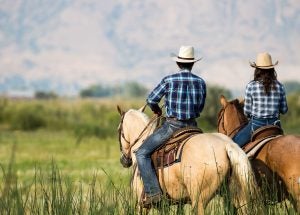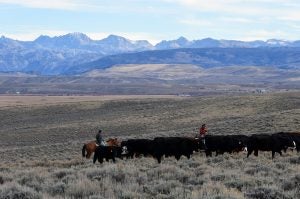Federal grazing has long been an issue of contention with some groups calling for the removal of livestock from public grazing lands. Yet, livestock grazing still takes place on about 250 million acres of public lands, most of those are located in the Western United States. During many seasons of the year, federal grazing is a major source of forage for ranches in the areas, and support for local economies.
To take a closer look, the University of Wyoming Extension completed an analysis on the economic impacts that removing livestock grazing on federal lands in Wyoming, Idaho, and Oregon would have. Using economic models, the researchers estimated the potential losses associated with the removal of federal grazing from cattle ranches in all three of the states.
“It is not just a one-state issue,” said UW Professor Emeritus David Taylor. “Sixteen states in the West have significant amounts of federal grazing and would be affected by changes in that grazing use.”
Within the three-state area of Idaho, Oregon, and Wyoming, there are 5,389 federal grazing permits that encompass 5.6 million Animal Unit Months in 97 of the 104 counties. Permits are issued for 10-year periods, so the removal of any permits who represent a cumulative impact over the 10-year-life of the permit.

It’s important to consider when reviewing this study that rural areas are notoriously dependent on agriculture to support area economies. Job opportunities for other employment in these areas is also limited.
For the purpose of the study, the assumption is made that cattle ranchers with federal grazing allotments would remain in business at a reduced production level. If ranches were not able to stay in business, the impacts would be far greater.
The total direct economic impact for federal grazing dependent ranches in the area was $652.1 million each year with about 80 percent coming from cattle production. The other 20 percent came from meadow and alfalfa hay sales.
Even more stark than the economic impacts is the estimated secondary impacts. Researchers who conducted the study included in secondary economic impacts feed stores, veterinarians, bulk fuel dealers, the total economic impact for the area was $1.5 billion which also supported over 10,000 employees and $415.2 million in labor income. A total secondary economic impact is estimated to be about $560.5 million annually and a yearly loss of more than 4,000 jobs.
Simply put: a $1 decrease in direct ranch sales due to a decrease in federal grazing allotments would cause a total $3.01 in economic activity throughout the state, including a $2.01 decrease in secondary impacts.
So, what does the 10-year impact look like? The total economic impact was estimated to be $3.9 billion. However, this reduction would also represent a loss of 41,000 job-years of employment and $1.4 billion for labor income.
How about over 40 years? The total economic impact was estimated to be $7.5 billion and a loss of 163,000 job-years of employment including $2.7 billion for labor income.

What the study doesn’t look at are the tightening cattle supplies in the United States. With tightening supplies due to drought and herd liquidations, the U.S. is on the bottom side of a 10-year cyclical trend. The loss of public lands grazing in the West would no doubt have far-reaching implications for other public lands grazing states and the entire industry cattle supply.


